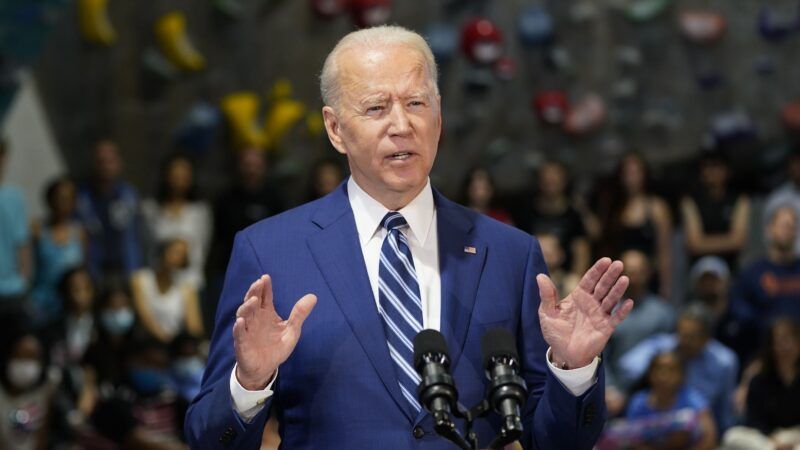Biden's $6 Trillion Budget Plan Is Even More Expensive Than It Looks
The White House chose not to include cost estimates for a number of big-ticket health care policies—while still expressing support for them.

There is little debate about what President Joe Biden's recent budget proposal represents. The headline figures speak for themselves: $6 trillion in federal spending this year, rising to more than $8 trillion in a decade, with deficits totaling at least $1.3 trillion every year in the process. It's a budget plan that The New York Times—in a news article, not an opinion piece—recently described as a call for "a permanent increase in the size of the federal footprint on the U.S. economy" and "an attempt to expand the size and scope of federal engagement in Americans' daily lives."
Biden's budget plan is a proposal, not a law, and it has not been passed by Congress. But it is a vision of America's fiscal future in which a substantially expanded federal government is at the center of much of everyday life. And if anything, its vision is actually more expansive than the headline figures represent.
That's because Biden's budget includes rhetorical support for a number of policies that it leaves out of its cost estimates. In particular, it expresses support for expanding Medicare, already among the most costly federal programs, by adding new benefits and expanding eligibility options to people as young as 60.
It also calls for the creation of a "public option"—a government-run health plan that would be sold alongside regulated private insurance plans on the health insurance plans created under the Affordable Care Act, also known as Obamacare.
Some reports have framed this move as Biden leaving out the public option, frustrating progressives who have long supported the creation of a government-run insurance plan. But while it's true that neither the public option nor the expansion of Medicare are included in Biden's budget estimates, I think this is not quite the right way to read the president's budget.
It's not that Biden left these health care expansions out of his budget. It's that he included them—without detailing how they would work or how much they would cost. Biden's budget is an attempt to push for these policies without having to wade into the sure-to-be-controversial policy mechanics or additional budgetary costs they would entail.
Biden's budget plan doesn't just vaguely suggest that expanding Medicare and creating a public option might be nice. Instead, in a paragraph that opens with an explicit call for Congress "to take action this year to further strengthen health care" by "expanding and improving health coverage," it declares that expanding Medicare, creating a public option, and a number of other health care policies are all part of "the President's health care agenda."
The Biden administration said in advance of the budget's release that several major health care initiatives had been postponed, and the budget wouldn't "propose new initiatives," and that's true enough in some technical sense.
But the clear expression of support means that these are, in effect, off-budget policies. But they would have a significant impact on both the budget and the delivery of health care services. Biden just won't say what that impact would be.
Biden's reluctance to specify how either policy would work goes back to his campaign. As the Kaiser Family Foundation recently noted, Biden's campaign proposal to let people aged 60–64 use Medicare leaves out many details: "Important policy design features have yet to be specified, including how it would be financed or administered." Put a little more bluntly, there isn't actually a plan here. But there is little doubt that adding millions of people to Medicare would increase total federal health care spending.
Similarly, Biden has declined to provide much in the way of specifics for how a government-run health insurance plan might work. Some analyses in the past have suggested that a public option might reduce the deficit. But such analyses also assume that the public option, like Medicare, would pay health care providers much lower rates than private insurance. Yet paying lower rates inevitably threatens patient access to care, especially at rural hospitals that serve poorer populations.
That helps explain why it's been politically difficult to make such plans work: Several years ago, Democrats in Washington state attempted to set up a state-run public option with rates close to Medicare's. It only passed after the rates came up.
A recent paper by a trio of policy analysts at the Hoover Institution, meanwhile, found that depending on how it was implemented and which taxes were used to offset the cost of the program, a public option could end up becoming the third-largest federal program, and running an $800 billion deficit over its first decade in operation. And because Congress would have control over the health insurance premiums charged by a government-run plan, it's easy to imagine that lawmakers would come under significant pressure to cap or otherwise limit increases to those premiums—offsetting the difference via additional taxes or deficit spending.
The point is that all of this is contentious, and any actual plan would inevitably spark significant debate and opposition from a wide constellation of interests. But Biden didn't want to have those debates or answer specific questions about his policies, so he tried to have it both ways, backing some major policy initiatives while pointedly declining to say how those initiatives would affect the budget. Which means that Biden's expansive, expensive budget plan—his vision for the federal government's fiscal future—is probably much more expansive and expensive than even the big headline numbers look.
Show Comments (53)